Assessing the Relationship between Measurement Length and Accuracy within Steady State Co-Heating Tests
Abstract
:1. Introduction
2. Background
2.1. Co-Heating Method
2.2. Duration of Co-Heating Measurements
2.3. Required Weather Conditions and Testing Season
2.4. Alternative Methods
2.5. Aims
- How long is required for accurate co-heating HTC estimates?
- How do HTC estimates evolve across test periods?
- When can co-heating tests be performed accurately?
- How do the above conditions vary with different building types?
3. Analysis of Field Tests
3.1. Method
3.2. The Use of ISO 9869 Criteria
- The test duration exceeds 72 h.
- The value obtained at the end does not deviate by more than ±5% from the value obtained 24 h before.
- The value obtained by analysing data from the first time period during two-thirds of measurement does not deviate by more than ±5% from the values obtained from the data of the last two-thirds.
3.3. Re-Analysis of Field Tests
3.4. Required Durations
3.5. Evidence of Uncertainty in Non-Converging Cases
3.6. ISO Criteria
3.7. Achieving Quasi-Steady State
4. Simulated Co-Heating Tests
- Internal temperature of 25 °C
- Vertical global solar radiation used in regression
- 24 hour aggregation (6 a.m.–6 a.m.)
- Multiple linear regression (no-intercept)
- Infiltration only (i.e., no ventilation)
- Electrical heating with 100% efficiency
- Uniform internal temperatures
- Quasi steady state conditions achieved
- No local shading
- Zero party wall heat transfer
4.1. Simulated Test Dwellings
4.2. Simulated Durations
4.3. Required Duration and Construction Type
4.4. Characteristics Determining Range of Suitable Test Conditions
5. Discussion
6. Conclusions
Acknowledgments
Author Contributions
Conflicts of Interest
References
- Doran, S. Field Investigations of the Thermal Performance of Construction Elements as Built; Building Research Establishment: Watford, UK, 2000. [Google Scholar]
- Baker, P.H. Technical Paper 10: U-Values and Traditional Buildings-In Situ Measurements and Their Comparisons to Calculated Values; Historic Scotland, Glasgow Caledonian University: Glasgow, UK, 2011. [Google Scholar]
- Rye, C. The SPAB Research Report 1: U-Value Report; Society for the Protection Ancient buildings: London, UK, 2011. [Google Scholar]
- Cesaratto, P.G.; De Carli, M.; Marinetti, S. Effect of different parameters on the in situ thermal conductance evaluation. Energy Build. 2011, 43, 1792–1801. [Google Scholar] [CrossRef]
- Adhikari, R.S.; Lucchi, E.; Pracchi, V. Experimental measurements on thermal transmittance of the opaque vertical walls in the historical buildings. In Proceedings of the PLEA2012—28th Conference, Opportunities, Limits & Needs towards an Environmentally Responsible Architecture, At Lima, Peru, 7–9 November 2012. [Google Scholar]
- Li, F.G.N.; Smith, A.Z.P.; Biddulph, P.; Hamilton, I.G.; Lowe, R.; Mavrogianni, A.; Oikonomou, E.; Raslan, R.; Stamp, S.; Stone, A.; et al. Solid-wall U-values: Heat flux measurements compared with standard assumptions. Build. Res. Inf. 2015, 43, 238–252. [Google Scholar] [CrossRef]
- Johnston, D.; Miles-Shenton, D.; Farmer, D. Quantifying the domestic building fabric ‘performance gap’. Build. Serv. Eng. Res. Technol. 2015, 36, 614–627. [Google Scholar] [CrossRef]
- Lowe, R.J.; Wingfield, J.; Bell, M.; Bell, J.M. Evidence for heat losses via party wall cavities in masonry construction. Build. Serv. Eng. Res. Technol. 2007, 28, 161–181. [Google Scholar] [CrossRef]
- Building Research Establishment (BRE). The UK Governments Standard Assessment Procedure (SAP); BRE: Garston, UK, 2013. [Google Scholar]
- Department for Communities and Local Government (DCLG). Conservation of Fuel and Power: Approved Document L1a; DCLG: London, UK, 2013.
- Lecompte, J. The influence of natural convection on the thermal quality of insulated cavity construction. Build. Res. Pract. 1990, 6, 349–354. [Google Scholar]
- Hens, H.; Janssens, A.; Depraetere, W.; Carmeliet, J.; Lecompte, J. Brick Cavity Walls: A Performance Analysis Based on Measurements and Simulations. J. Build. Phys. 2007, 31, 95–124. [Google Scholar] [CrossRef]
- Bankvall, C. Practical thermal conductivity in an insulated structure under the influence from workmanship and wind. In Proceedings of the ASTM symposium on Advances in Heat Transmission Measurement on Thermal Insulation Material Systems, Philadelphia, PA, USA, 19–20 September 1977. [Google Scholar]
- Zero Carbon Hub (ZCH). Closing the Gap between Design & As-Built Performance—Evidence Review Report; ZCH: Birmingham, UK, 2014. [Google Scholar]
- International Organization for Standardization (ISO). BS EN 1946-4:2000—Measurements by Hot Box Methods; International Organization for Standardization (ISO): Geneva, Switzerland, 2000. [Google Scholar]
- Carrié, R.; Kapsalaki, M.; Wouters, P. Right and Tight: What’s new in Ductwork and Building Airtightness? In Proceedings of the 34th AIVC—3rd TightVent—2nd Cool Roof Conference—1st Venticool Conference, Athens, Greece, 25–26 September 2013. [Google Scholar]
- ISO 9869-1:2014—Thermal Insulation—Building Elements—In-Situ Measurement of Thermal Resistance and thermal Transmittance—Part. 1: Heat Flow Meter Method; International Organization for Standardization (ISO): Geneva, Switzerland, 2014.
- International Organization for Standardization (ISO). BS EN ISO 13790:2008 Energy Performance of Buildings. Calculation of Energy Use for Space Heating and Cooling; ISO: Geneva, Switzerland, 2008. [Google Scholar]
- Baker, P.H. A Retrofit of a Victorian Terrace House in New Bolsover: A Whole House Thermal Performance Assessment; Historic England & Glasgow Caledonian University: Glasgow, UK, 2015. [Google Scholar]
- Wingfield, J. In Situ Measurement of Whole House Heat Loss Using Electric Coheating; Leeds Metropolitan University: Leeds, UK, 2010. [Google Scholar]
- Johnston, D.; Miles-Shenton, D.; Farmer, D.; Wingfield, J. Whole House Heat Loss Test Method (Coheating); Leeds Metropolitan University: Leeds, UK, 2013. [Google Scholar]
- Bauwens, G.; Roels, S. Co-heating test: A state-of-the-art. Energy Build. 2014, 82, 163–172. [Google Scholar] [CrossRef]
- Stamp, S.F. Assessing Uncertainty in Co-Heating Tests: Calibrating a Whole Building Steady State Heat Loss Measurement Method. Ph.D. Thesis, UCL (University College London), London, UK, 2016. [Google Scholar]
- Butler, D.; Dengel, A. NHBC Review of Co-Heating Test Methodologies; National House Building Council Foundation (NHBC): Milton Keynes, UK, 2013. [Google Scholar]
- Bell, M.; Lowe, R.J. The York Energy Demonstration Project—Final Report; Leeds Metropolitan University: Leeds, UK, 1998. [Google Scholar]
- Bell, M.; Wingfield, J.; Miles-Shenton, D.; Seavers, J. Low Carbon Housing—Lessons from Elm Tree Mews; Leeds Metropolitan University and Joseph Rowntree Foundation: Leeds, UK, 2010. [Google Scholar]
- Wingfield, J.; Bell, M.; Miles-Shenton, D.; Seavers, J. Elm Tree Mews Field Trial—Evaluation and Monitoring of Dwellings Performance—Final Technical Report; Leeds Metropolitan University: Leeds, UK, 2011. [Google Scholar]
- Miles-Shenton, D.; Wingfield, J.; Sutton, R.; Bell, M. Temple Avenue Project—Summary Report; Leeds Metropolitan University: Leeds, UK, 2011. [Google Scholar]
- Good Homes Alliance (GHA). GHA Monitoring Programme. 2009–2011: Technical Report—Results from Phase 1: Post-Construction Testing of a Sample of Highly Sustainable New Homes; Good Homes Alliance: London, UK, 2011. [Google Scholar]
- Palmer, J.; Godoy-Shimizu, D.; Tillson, A.; Mawditt, I. Bulding. Performance Evaluation Programme: Findings from Domestic Projects—Making Reality Match Design; Innovate UK: Swindon, UK, 2016.
- Latif, E.; Lawrence, M.; Shea, A.; Walker, P. In situ assessment of the fabric and energy performance of five conventional and non-conventional wall systems using comparative coheating tests. Build. Environ. 2016, 109, 68–81. [Google Scholar] [CrossRef]
- Johnston, D.; Farmer, D.; Miles-Shenton, D. Quantifying the aggregate thermal performance of UK holiday homes. Build. Serv. Eng. Res. Technol. 2017, 38, 209–225. [Google Scholar] [CrossRef]
- Farmer, D.; Gorse, C.; Swan, W.; Fitton, R.; Brooke-Peat, M.; Miles-Shenton, D.; Johnston, D. Measuring thermal performance in steady-state conditions at each stage of a full fabric retrofit to a solid wall dwelling. Energy Build. 2017. [Google Scholar] [CrossRef]
- Department of Communities and Local Government (DCLG). 2012 Consultation on Changes to the Building Regulations in England—Section Two—Part. L (Conservation of Fuel and Power); DCLG: London, UK, 2012.
- Everett, R. Rapid Thermal Calibration of Houses; Open University Energy Research Group: Milton Keynes, UK, 1985. [Google Scholar]
- Lowe, R.J.; Gibbons, C.J. Passive solar houses: Availability of weather suitable for calibration in the UK. Build. Serv. Eng. Res. Technol. 1988, 9, 127–132. [Google Scholar] [CrossRef]
- Alexander, D.K.; Jenkins, H.G. The Validity and Reliability of Co-heating Tests Made on Highly Insulated Dwellings. Energy Procedia 2015, 78, 1732–1737. [Google Scholar] [CrossRef]
- Baker, P.H.; van Dijk, H.A.L. PASLINK and dynamic outdoor testing of building components. Build. Environ. 2008, 43, 143–151. [Google Scholar] [CrossRef]
- Judkoff, R.; Balcomb, J.; Hancock, C.; Barker, G.; Subbarao, K. Side-by-Side Thermal Tests of Modular Offices: A Validatioin Study of the STEM Method; National Renewable Energy Laboratory: Golden, CO, USA, 2000.
- Sonderegger, R.C.; Modera, M.P. Electric co-heating: A method for evaluating seasonal heating efficiencies and heat loss rates in dwellings. In Proceedings of the Second International CIB Symposium, Copenhagen, Demark, 28 May–1 June 1979. [Google Scholar]
- Sonderegger, R.C.; Condon, P.E.; Modera, M.P. In-Situ Measurement of Residential Energy Performance Using Electric Coheating. In Proceedings of the American Society of Heating Refrigerating and Air Conditioning Engineers Semi-Annual Meeting Transactions, Los Angeles, CA, USA, 3 February 1980; Volume 86, p. 394. [Google Scholar]
- Subbarao, K. Primary and Secondary Terms-Analysis and Renormalization: A Unified Approach to Building and Energy Simulations and Short-Term Testing—A Summary; Solar Energy Research Institute: Colorado, CO, USA, 1988. [Google Scholar]
- Mangematin, E.; Pandraud, G.; Roux, D. Quick measurements of energy efficiency of buildings. C. R. Phys. 2012, 13, 383–390. [Google Scholar] [CrossRef]
- Pandruad, G.; Fitton, R. QUB: Validation of a rapid energy diagnosis method for buildings. In Proceedings of the Characterisation Based on Full Scale Dynamic Measurements 4th Expert Meeting, Holenkirchen, Germany, 8–10 April 2013. [Google Scholar]
- Andrews, J.W. Electric Coheating as a Means to Test Duct Efficiency: A Review and Analysis of the Literature; Brookhaven National Laboratory: New York, NY, USA, 1995.
- Liu, M.; Claridge, D.E. Improving Building Energy Performance through Continuous Commissioning; Energy Systems Laboratory, Texas A & M.: College Station, TX, USA, 1995. [Google Scholar]
- Roels, S.; Bacher, P.; Bauwens, G.; Madsen, H.; Jiménez, M.J. Characterising the Actual Thermal Performance of Buildings: Current Results of Common Exercises Performed in the Framework of the IEA EBC Annex 58-Project. Energy Procedia 2015, 78, 3282–3287. [Google Scholar] [CrossRef] [Green Version]
- Roels, S.; Bacher, P.; Bauwens, G.; Castaño, S.; Jiménez, M.J.; Madsen, H. On site characterisation of the overall heat loss coefficient: Comparison of different assessment methods by a blind validation exercise on a round robin test box. Energy Build. 2017, 153, 179–189. [Google Scholar] [CrossRef]
- Farmer, D.; Johnston, D.; Miles-Shenton, D. Obtaining the heat loss coefficient of a dwelling using its heating system (integrated coheating). Energy Build. 2016, 117, 1–10. [Google Scholar] [CrossRef]
- Jack, R. Building Diagnostics: Practical Measurement of the Fabric Thermal Performance of Houses. Ph.D. Thesis, Loughborough University, Loughborough, UK, 2015. [Google Scholar]
- Jack, R.; Loveday, D.; Allinson, D.; Lomas, K. First evidence for the reliability of building co-heating tests. Build. Res. Inf. 2017, 1–19. [Google Scholar] [CrossRef]
- Joint Committee for Guides in Metrology (JCGM). JCGM 100:2008—Evaluation of Measurement Data—Guide to the Expression of Uncertainty in Measurement; JCGM: Paris, France, 2008. [Google Scholar]
- PD 6461-4:2004—General Metrology. Practical Guide to Measurement Uncertainty. Available online: https://shop.bsigroup.com/ProductDetail/?pid=000000000030044787 (accessed on 3 October 2017).
- Feist, W. Passive House Planning Package; Passivhaus Institut: Darmstadt, Germany, 2007. [Google Scholar]
- EnergyPlus Weather Data by Location. Available online: https://energyplus.net/weather-location/europe_wmo_region_6/GBR/GBR_Finningley.033600_IWEC (accessed on 15 November 2016).
- Stamp, S.; Altamirano-Medina, H.; Lowe, R. Measuring and accounting for solar gains in steady state whole building heat loss measurements. Energy Build. 2017, 153, 168–178. [Google Scholar] [CrossRef]
- Johnston, D.; Siddall, M. The Building Fabric Thermal Performance of Passivhaus Dwellings—Does It Do What It Says on the Tin? Sustainability 2016, 8. [Google Scholar] [CrossRef]

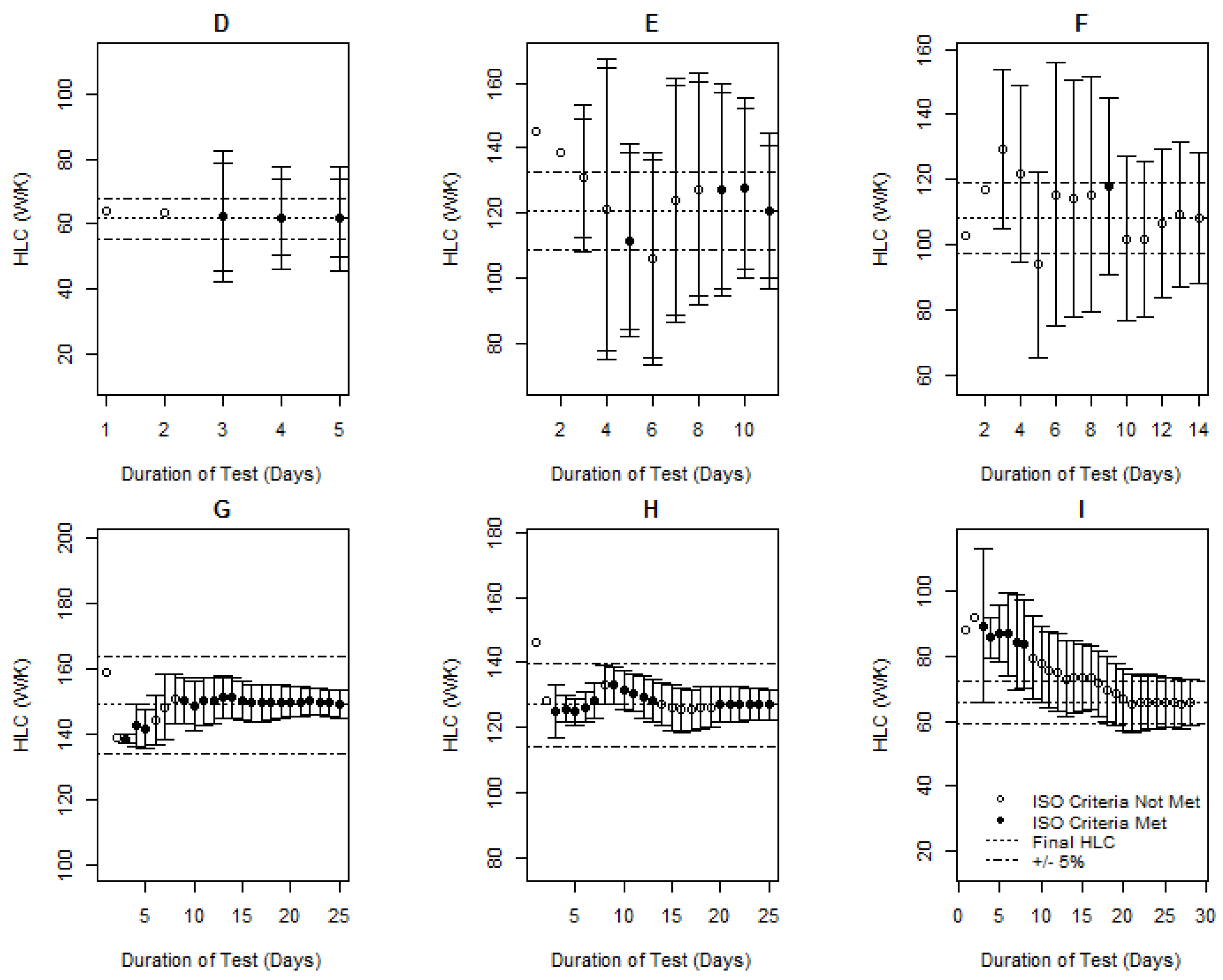
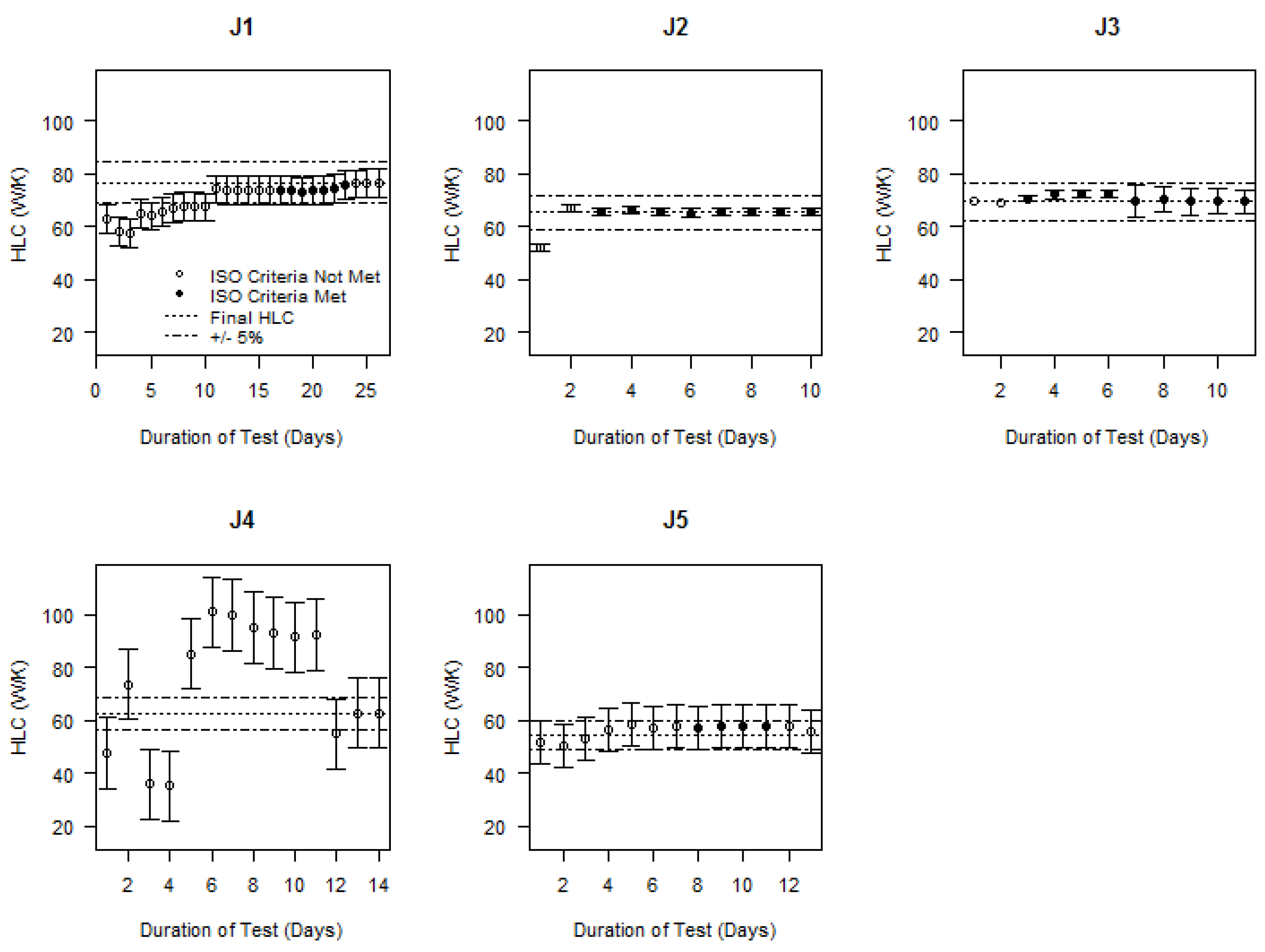

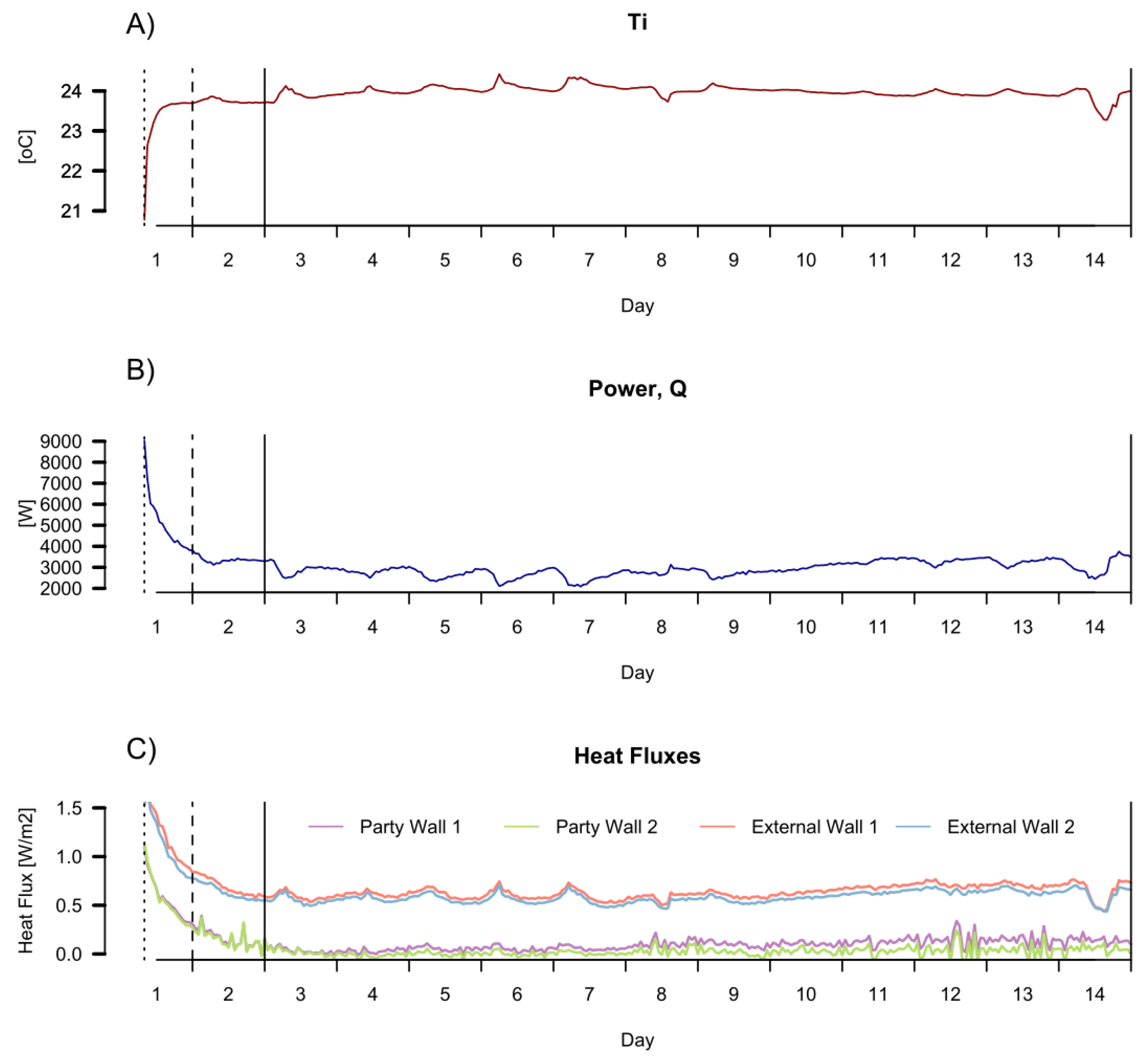
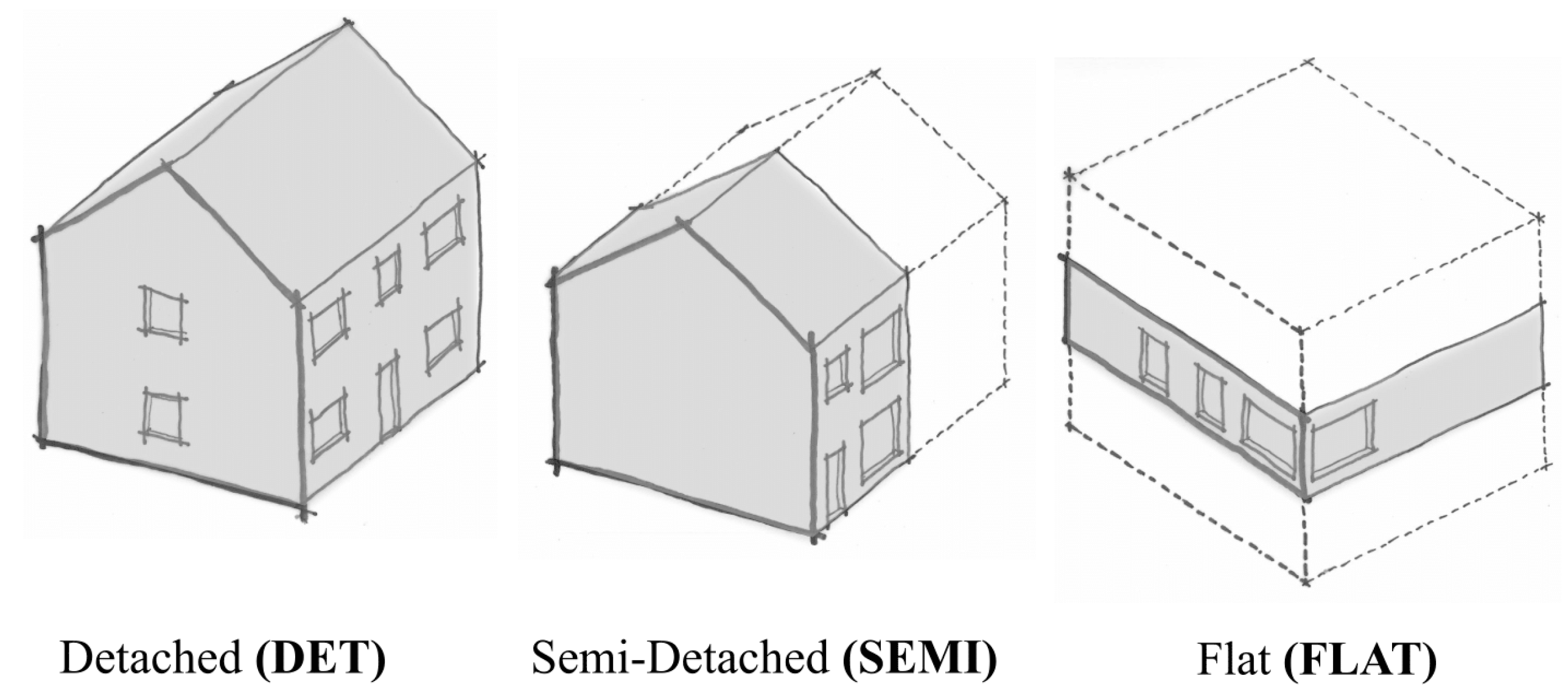
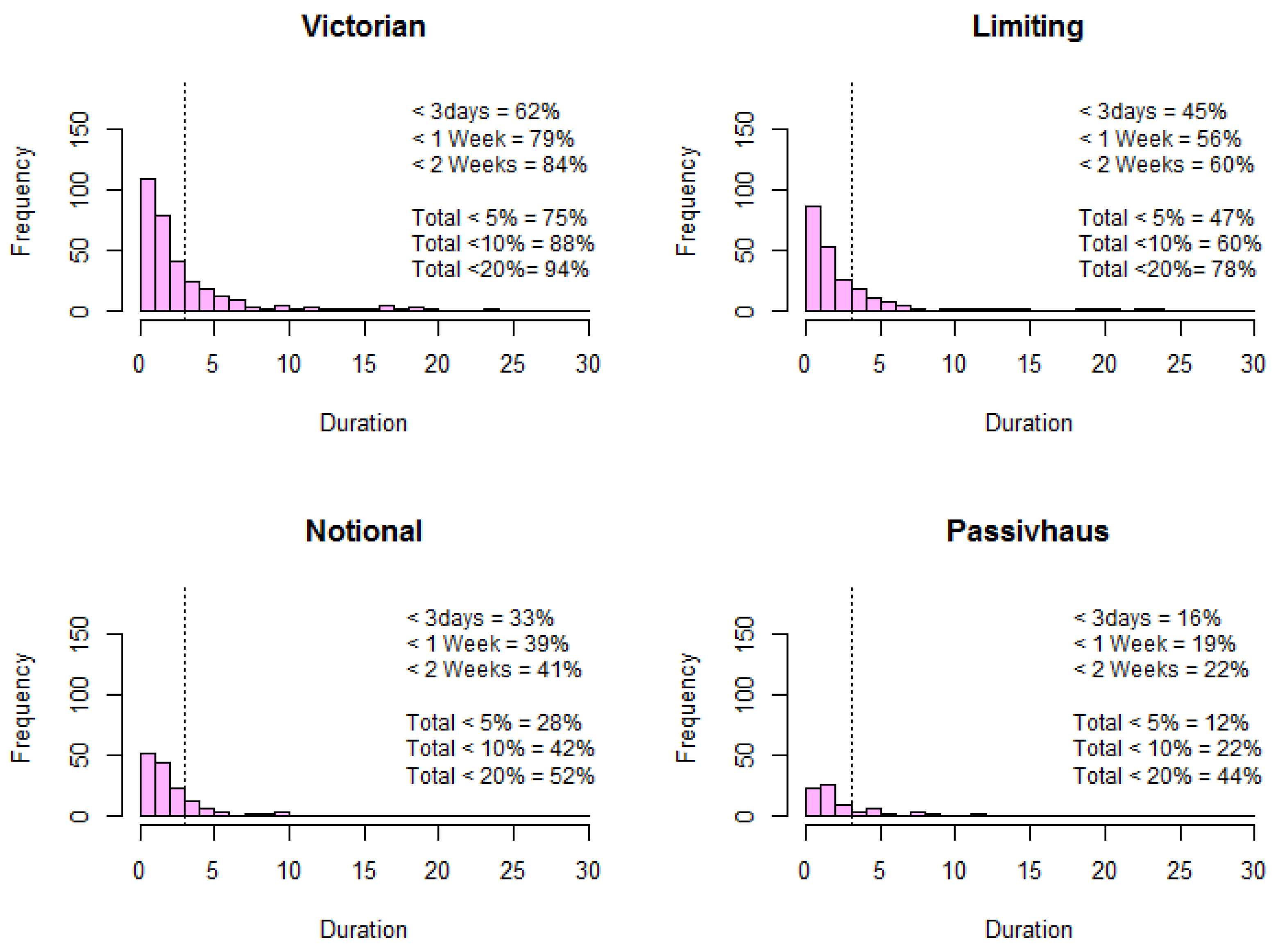
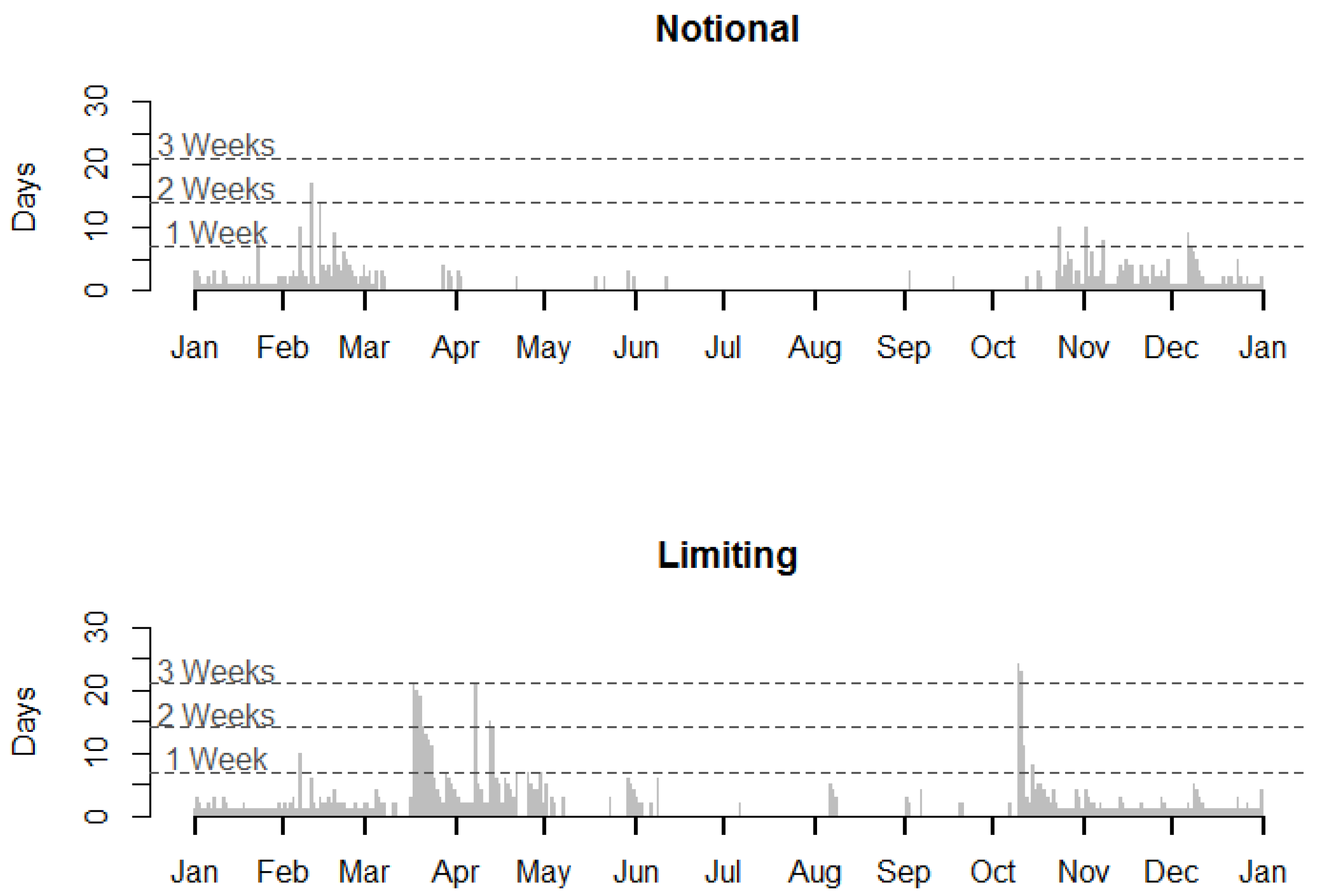
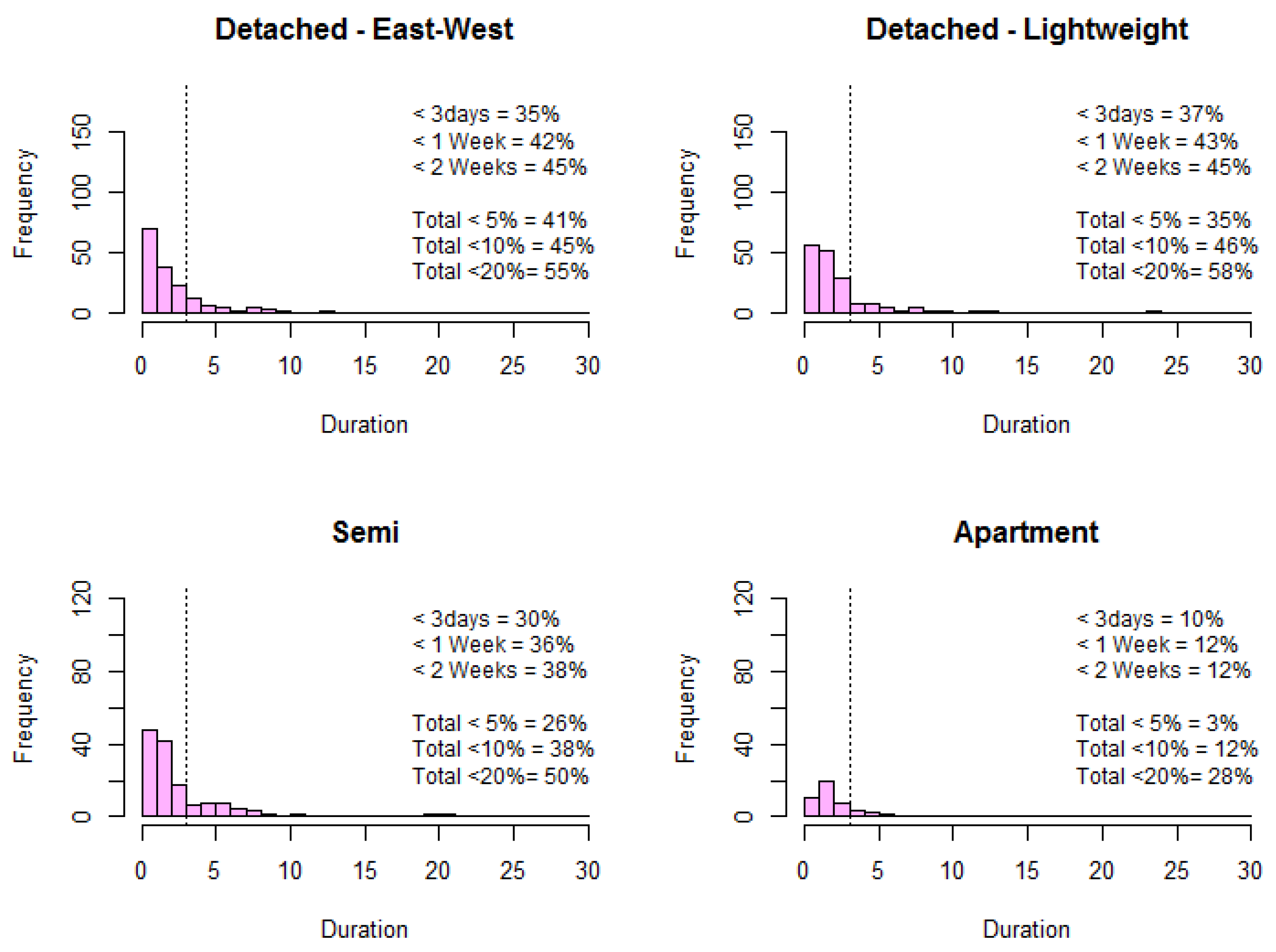
| Case | When | Hmeas (W/K) | Hpred (W/K) | Construction | Type | Notes |
|---|---|---|---|---|---|---|
| Primary Cases | ||||||
| A1 | January–February | 243 ± 10 | 212 | Brick-cavity-block (un-insulated) | Semi | One guarded adjoining property (Case B1). Both horizontal and vertical solar measurements taken. |
| A2 | March–April | 144 ± 10 | 112 | Brick-cavity-block (insulated) | Semi | Same dwelling as above, after cavity walls insulated. |
| B1 | March–April | 113 ± 33 | 105 | Brick-cavity-block (insulated) | Mid-terrace | One party wall guarded, one unguarded. |
| B2 | January–February | 111 ± 24 | 105 | Brick-cavity-block (insulated) | Mid-terrace | One party wall unguarded, one unguarded. Repeated test of case B1. |
| C | March | 238 ± 21 | 205 | Masonry thin-joint | Detached | Large detached |
| D | December | 62 ± 16 | 66 | Timber frame with lower concrete retaining walls | Detached | Passivhaus dwelling. |
| E | December | 121 ± 23 | 78 | Aerated blocks | Detached | Horizontal solar radiation measured. |
| Secondary Cases | ||||||
| F | February | 108 ± 20 | 94 | Aerated blocks | Semi | Horizontal solar radiation measured. Unguarded neighbouring property. |
| G | January–February | 149 ± 8 | 129 | Masonry thin-joint | Detached | [28] |
| H | January–February | 127 ± 5 | 120 | Structurally insulated panel | Detached | [28] |
| I | March–April | 66 ± 7 | 38 | Clay-block in concrete frame | Corner apartment | Guarded and unguarded surrounding apartments. |
| J1–J5 | February | 56–76 | 68 | Brick clad timber frame | Detached | Detached dwelling, tested by various organisations between December–April [24] |
| Test Case | Days <20% | Days <10% | Days <5% | Days to ISO | Monitoring Durations | Warm Up Period |
|---|---|---|---|---|---|---|
| A1 (SGHR) | 1 | 2 | 2–4 *, 11 | - | 24 | 5 |
| A1 (SGVS) | 1 | 3 | 3 | 4 | 8 | 5 |
| A2 | 1 | 1 | 2 | 3 | 11 | 2 |
| B1 | 1 | 2 | 2 | - | 24 | 5 |
| B2 | 1 | 1 *, 3 | 1 *, 7 | 10 | 11 | 2 |
| C | 1 *,3 | 3 | 3 | 3 | 14 | 4 |
| D | 2 | 2 | 3 | 3 | 5 | 1 |
| E | 1 | 1 | 1*,3 | 9 | 13 | 5 |
| F | 1 | 5 | 12 | - | 14 | - |
| G | 1 | 2 | 2 | 9 | 25 | - |
| H | 1 | 1 | 2 | 20 | 25 | - |
| I | 10 | 17 | 19 | - | 29 | - |
| J1 | 1 *, 4 | 11 | 11 | - | 28 | - |
| J2 | 2 | 2 | 2 | 3 | 10 | - |
| J3 | 1 | 1 | 1 | 3 | 11 | 1 |
| J4 | 2 *, 12 | 13 | 13 | - | 14 | - |
| J5 | 1 | 1 | 3 | - | 13 | - |
| Built Form | Detached | Semi | Apartment |
|---|---|---|---|
| Floor Area (footprint) | 58.1 m2 | 38 m2 | 67 m2 |
| Total Floor Area | 116.3 m2 | 76 m2 | 67 m2 |
| Volume | 348.9 m3 | 190.1 m3 | 167.5 m3 |
| Envelope area (exc. Ground floor) | 242.0 m2 | 127.3 m2 | 55 m2 |
| Party wall/floor area | - | 35 m2 | 190.3 m2 |
| Glazed area | 21.3 m2 | 16.1 m2 | 14.7 m2 |
| Glazing fraction | 18.3% | 21.2% | 21.9% |
| Construction | Walls | Ground Floor | Glazing | Roof | Mean ACH | Partition Walls | Internal Floors |
|---|---|---|---|---|---|---|---|
| Victorian | 220 mm Solid Brick walls (2.1 W/m2K) | Uninsulated suspended timber floor (0.8 W/m2K) | Single glazing (4.8 W/m2K, g = 0.85) | Pitched roof, uninsulated (2.3 W/m2K) | 0.82 h−1 | 110 mm solid brick, plaster | Timber, plaster on lathe |
| Modern dwellings | Full fill brick and aircrete block | Insulated concrete floor | Double glazing (1.4 W/m2K, g = 0.63) | Pitched roof—insulated at ceiling level | - | 12 mm plaster-lightweight block-12 mm plaster | Timber, plasterboard |
| Limiting | 0.30 W/m2K | 0.25 W/m2K | 2.0 W/m2K g = 0.76 | 0.20 W/m2K | 0.57 h−1 | - | - |
| Notional | 0.18 W/m2K | 0.13 W/m2K | 1.4 W/m2K g = 0.63 | 0.13 W/m2K | 0.23 h−1 | - | - |
| Passivhaus | 0.15 W/m2K | 0.15 W/m2K | 0.85 W/m2K g = 0.5 | 0.15 W/m2K | 0.03 h−1 | - | - |
© 2017 by the authors. Licensee MDPI, Basel, Switzerland. This article is an open access article distributed under the terms and conditions of the Creative Commons Attribution (CC BY) license (http://creativecommons.org/licenses/by/4.0/).
Share and Cite
Stamp, S.; Altamirano-Medina, H.; Lowe, R. Assessing the Relationship between Measurement Length and Accuracy within Steady State Co-Heating Tests. Buildings 2017, 7, 98. https://doi.org/10.3390/buildings7040098
Stamp S, Altamirano-Medina H, Lowe R. Assessing the Relationship between Measurement Length and Accuracy within Steady State Co-Heating Tests. Buildings. 2017; 7(4):98. https://doi.org/10.3390/buildings7040098
Chicago/Turabian StyleStamp, Samuel, Hector Altamirano-Medina, and Robert Lowe. 2017. "Assessing the Relationship between Measurement Length and Accuracy within Steady State Co-Heating Tests" Buildings 7, no. 4: 98. https://doi.org/10.3390/buildings7040098




